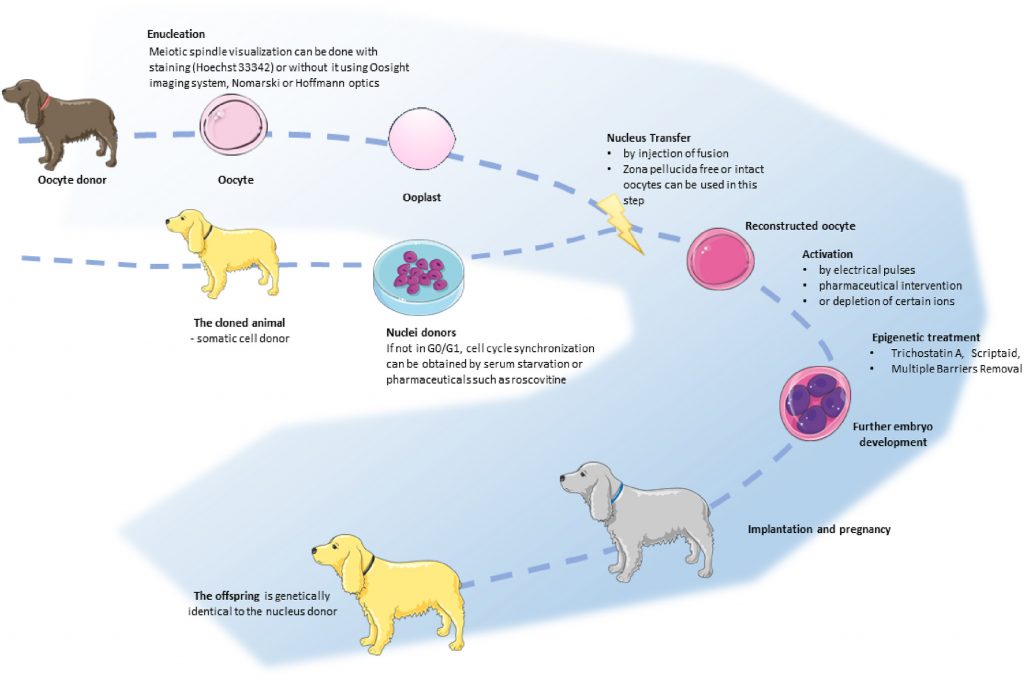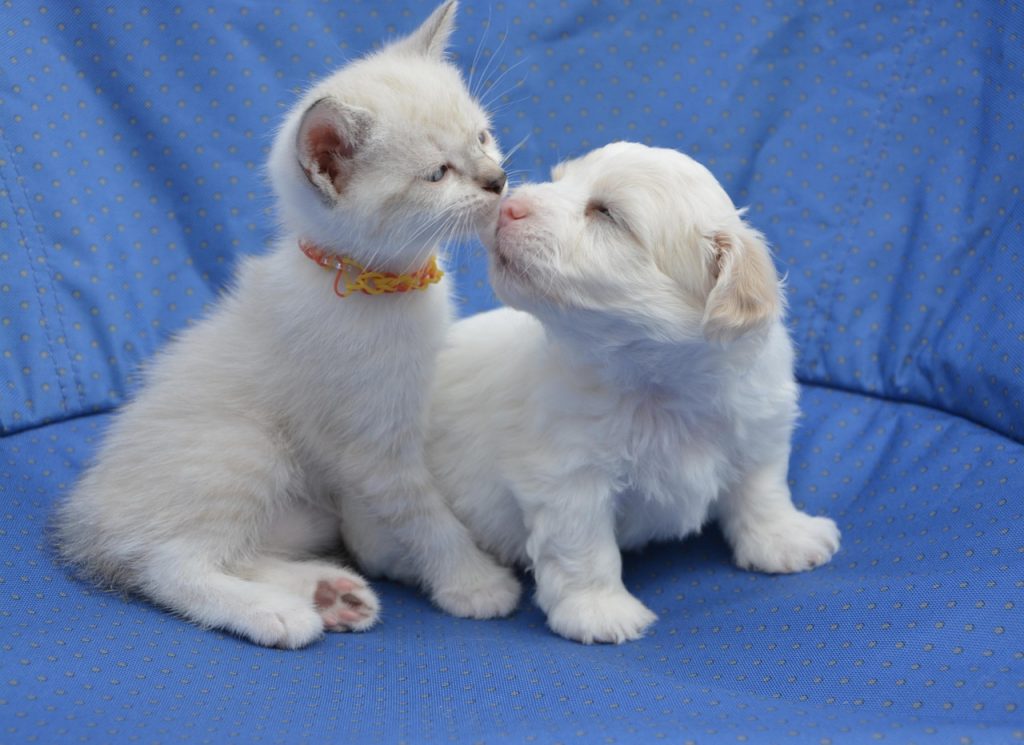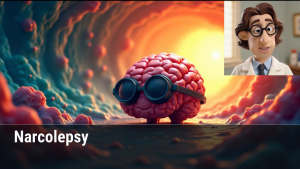The pet cloning industry allows for a person to create and purchase a genetic clone of their pet. It raises ethical concerns about the mental and physical well-being of all of the animals involved in the process, including the cloned offspring and the surrogate mothers, as well as concerns about what is done with retired surrogate mothers and clones not purchased by customers. Supporters of pet cloning claim that businesses take good care of animals involved in the process. People who have purchased clones of their pet have been content with the result of the cloning. Those who are against pet cloning claim that there are health risks involved in the process for surrogate mothers and cloned offspring. They believe that risking the welfare of animals is not worth the ability to purchase a clone of a pet.

Pet cloning is done through a process called somatic cell nuclear transfer (SCNT). In the process of SCNT, a somatic cell is taken from a tissue sample provided by the animal that is to be cloned. The nucleus is removed from a donor oocyte in order to remove the DNA from the donor cell. The somatic cell is then transferred to the enucleated oocyte. The oocyte then reconstructs. Next, the cell is chemically or electrically stimulated in order to encourage embryonic development of the cell. An embryo can then be implanted in a surrogate mother. The offspring produced will be genetically identical to the animal from which the somatic cell sample was taken.1
Through a Texas-based company called ViaGen Pets, which is currently the only company to offer these services in the United States, pet cloning has been available to customers since 2015. A customer may purchase a clone of their dog or cat for $50,000. The company guarantees that the cloned puppy or kitten provided to the customer will be inspected and deemed healthy by a veterinarian. According to their website, “regular health checks are performed on animals to ensure the health and wellbeing of the animals.”2 The company has assured that they only euthanize clones when they have life-threatening issues, and that surrogate mothers are limited to delivering two litters. If a litter results in more than one clone, all of the clones are offered to the customer. If the customer does not take all of the clones, they help customers adopt out the pets. The company has also said that they spay and place retired surrogate mothers for adoption as well.3 There does not appear to be any publicized data which shows specifically how many animals end up getting adopted, however. There also does not appear to be any publicized data documenting the exact process and the details surrounding the company helping to adopt out the extra clones and surrogate mothers.
Some studies have found that the lifespans of clones are generally similar to normal lifespans in dogs and cats. One study examined cases of various cloned mammals and compared the telomere length, which has been associated with aging and aging disorders, in the clones and the original animal to determine if there were any significant differences. Although the study was restricted due to a limited amount of data available, it found there was no significant difference in telomere length for the two dogs and seven cats it examined.4 While cloned dogs and cats have been found to not have significant differences in telomere length, another study suggests there may be mutations that result in other cellular differences between cloned and non-cloned dogs. This study found, when comparing the cloned dogs to the original dog, the clones had somatic mutations not found in the original dog. These mutations were related to genes associated with tumors and human aging.5
Cloned dogs that are delivered alive and without birth defects have been found to typically live a relatively normal life with health risks similar to that of non-cloned dogs. These cloned dogs have been found to exhibit growth characteristics such as height and weight, hematological characteristics such as blood counts, and reproductive characteristics such as hormone levels and production of gametes within the norm.6
Cloning using the SCNT method has been found to have certain difficulties related to the fertilization process. Success rates for transfer of oocytes to a surrogate mother are low, with most oocytes not developing. The success rate of cloning is around 4% in dogs, although factors such as breed of the dog may affect this number. Embryos also have a low survival rate.7
A possible reason for the low success rate of cloning using SCNT could be related to the lower volume of cytoplasm in the oocytes used in the process. In one study, CICT (cytoplasm injection cloning technology) was used in cat cloning in an attempt to increase the efficiency of cloning using the SCNT method. It involved fusing an oocyte with additional cytoplasm. This was found to increase the efficacy of the SCNT method.8 While improvements are being made to the cloning process, in order to raise the success rates, improvements must continue to be made.

There are also risks associated with the pregnancy and birthing process of pet cloning. Difficulties related to pregnancy and delivery may cause stress and anxiety for the surrogate mother. Clones in general have higher rates of death of the offspring shortly after birth and developmental abnormalities in comparison to natural births. These developmental abnormalities may include low birth weight, respiratory issues, being more vulnerable to disease, and issues related to organ development. Surrogate mothers may also experience abnormalities and issues during pregnancy including large fetal size, placental abnormalities, and higher abortion rates. Surrogate mothers may subsequently need to deliver offspring via C-section rather than natural birth.9
The issue of animal dignity and autonomy can also be considered. The animals involved in this process cannot consent to being a part of it. Because animals cannot consent in the way humans can, their best interest must be considered. If a pet needs surgery, they clearly cannot consent to the procedure being done. However, the pet’s owner may decide that the surgery is in the best interest of the animal and decide to go through with it. How does this compare to the process of pet cloning and its use of surrogate mothers? One perspective might be that procedures should only be done to pets when there is risk to their health if not done. Another perspective might be that some unnecessary procedures are okay, depending on the reason they are done. Either way, the potential risks must be given careful thought.

The emotional and mental well-being of customers could also be considered. Many customers have expressed grief over losing a beloved pet as their reason for choosing to purchase a cloned dog or cat. One woman, who suddenly lost her five-year-old cat in a traffic accident, stated that she felt “there was more living that needed to be done” by her cat.10 Actress and singer Barbra Streisand cloned her dog, stating that “it was easier to let [her dog] go” if she “could keep some part of her alive.”11 One man even sold his car to be able to afford cloning his deceased dog.12 While there have been several people who have gone through this process and expressed satisfaction with their clone of their beloved pet, some studies show that this may not be the most effective way to cope with pet-loss grief. These studies suggest that replacing a pet who was special to and loved by the owner may not actually be dealing with the pain of the loss. It is possible that it simply postpones the grief rather than eliminating or mitigating the grief.13 Therefore, there is concern about the mental well-being of the people who choose to do this while experiencing the grief of losing their pet.
Around the world, the legality of pet cloning varies by country. There are currently no bans on pet cloning in the United States. Another country that provides the service of pet cloning is Spain. Through Ovoclone, a customer can purchase a clone of their dog, cat, or horse.14 In the United Kingdom it is not legal to clone a pet, but it is legal to preserve genetic material for cloning and to own a cloned pet. Companies, like UK-based Gemini Genetics, work with U.S. company, ViaGen Pets, in order to facilitate the service.15 Therefore, despite the pet cloning process being illegal in the UK, there are legal workarounds available for those that wish to clone their pet. The differing laws surrounding pet cloning further show the varied opinions that people have on the matter of pet cloning.
Bernard Lonergan, a Jesuit and theologian, created a framework of consciousness which can be used in considering ethical issues. Lonergan’s four transcendental imperatives include being attentive in experience, being intelligent in understanding, being reasonable in judgement, and being responsible in deciding.16 The issue of whether pet cloning is ethically acceptable can be analyzed through this framework.
There are several concerns relevant to the topic at hand including physical and mental well-being of the animals involved. A question of whether this process of cloning pets is safe and justifiable is present. Lonergan calls for a consideration of the evidence and facts first. While they may not be present in every pregnancy or in every cloned pet, there is evidence of abnormalities in the pregnancy and the birthing process of clones, as well as developmental abnormalities in cloned animals.17 There needs to be an understanding of these risks before a decision can be made of whether or not this procedure ought to be done. The exact causes of these associated complications and abnormalities should be studied. There should be thought given to whether something can be done to reduce the complications that are associated with the process of cloning.
Lonergan also calls for being reasonable in judgement before forming a decision. The goodness and morality of the issue must be determined. Is it morally just to clone a pet? There needs to be good or value that comes from the practice. It could be argued that there is good in providing comfort to grieving pet owners or a loving companion to a person seeking very specific traits in a pet. However, it appears that this good is not enough to justify the complications that are possible. It does not seem responsible to clone a pet, knowing there are potential risks, simply to satisfy a human desire.
Overall, it seems there needs to be more extensive research done on this topic in order to deem it safe for all of the animals involved. The current research on cat cloning and dog cloning is limited, and some studies that have been done are small-scale rather than examining large groups of cloned animals at a time. While there have been improvements in SCNT methods made over the years, there are still several complications associated with the process that need to be carefully considered. Success rates of pregnancy by this process are still relatively low, and even the successful pregnancies have associated risks. There are also concerns regarding consent and dignity of the animal. It must be considered whether it is justifiable to subject animals to this process for this purpose even if there were absolute certainty that there are no physical health risks involved. It is important to approach the topic of pet cloning thoughtfully and to carefully weigh any possible benefits and dangers. Regardless of personal opinion on the subject, it is clear that there are many factors to take into account when approaching the ethics of pet cloning including the well-being of animals involved as well as the emotional effects it has on humans.
- Katarzyna Malin et al., “The Many Problems of Somatic Cell Nuclear Transfer in Reproductive Cloning of Mammals,” Theriogenology 189 (September 2022): 246–54, https://doi.org/10.1016/j.theriogenology.2022.06.030. ↵
- “Pet Cloning FAQ’s. Got Questions About Animal Cloning?,” Viagen Pets, n.d., accessed October 8, 2025, https://www.viagenpets.com/faq/. ↵
- Andrea Day Joseph Ray Parisi,Jessi, “Grief-Stricken Pet Owners Usher in Instagram and TikTok’s New Influencers: Their Cloned Cats and Dogs,” CNBC, February 16, 2022, https://www.cnbc.com/2022/02/16/cloned-cats-and-dogs-become-newest-influencers-on-instagram-and-tiktok.html. ↵
- Jörg Patrick Burgstaller and Gottfried Brem, “Aging of Cloned Animals: A Mini-Review,” Gerontology 63, no. 5 (2017): 417–25, https://doi.org/10.1159/000452444. ↵
- Seung-Wan Woo et al., “Genome-Wide Characterization of Somatic Mutation Patterns in Cloned Dogs Reveals Implications for Neuronal Function, Tumorigenesis, and Aging,” Genes 15, no. 6 (2024): 801, https://doi.org/10.3390/genes15060801. ↵
- Min Jung Kim et al., “Birth of Clones of the World’s First Cloned Dog,” Scientific Reports 7, no. 1 (2017): 15235, https://doi.org/10.1038/s41598-017-15328-2. ↵
- K. Heðinsdóttir et al., “Can Friends Be Copied? Ethical Aspects of Cloning Dogs as Companion Animals,” Journal of Agricultural and Environmental Ethics 31, no. 1 (2018): 17–29, https://doi.org/10.1007/s10806-018-9706-y. ↵
- Seok-Hwan Song et al., “Production of Cloned Cats Using Additional Complimentary Cytoplasm,” Animal Reproduction Science 208 (September 2019): 106125, https://doi.org/10.1016/j.anireprosci.2019.106125. ↵
- Heðinsdóttir et al., “Can Friends Be Copied?” ↵
- “Woman Receives 2 Clones of Her Late Cat for $50,000 After 2 Failed Attempts to Copy the Pet,” People.Com, accessed October 8, 2025, https://people.com/woman-receives-two-clones-of-beloved-cat-for-50-000-8612822. ↵
- “Barbra Streisand Defends Decision to Clone Her Dog: ‘I Knew I Could Keep Some Part of Her Alive,’” People.Com, accessed October 8, 2025, https://people.com/pets/barbra-streisand-defends-decision-to-clone-her-dog/. ↵
- “Some Spend Big Bucks on Pet Cloning. CBS News New York Investigates the Industry. – CBS New York,” August 16, 2024, https://www.cbsnews.com/newyork/news/pet-cloning-industry-viagen-pets/. ↵
- Ben Hughes and Beth Lewis Harkin, “The Impact of Continuing Bonds Between Pet Owners and Their Pets Following the Death of Their Pet: A Systematic Narrative Synthesis,” Omega 90, no. 4 (2025): 1666–84, https://doi.org/10.1177/00302228221125955. ↵
- “Pet Cloning,” Ovoclone, n.d., accessed October 27, 2025, https://ovoclone.com/en/pet-cloning/. ↵
- “FAQ – Gemini Genetics,” July 14, 2021, https://www.geminigenetics.com/frequently-asked-questions/. ↵
- Martin K. Jones, “The Four Transcendental Imperatives of Bernard Lonergan,” Equivalent Exchange, December 9, 2015, https://equivalentexchange.blog/2015/12/09/the-four-transcendental-imperatives-of-bernard-lonergan/. ↵
- Heðinsdóttir et al., “Can Friends Be Copied?” ↵



